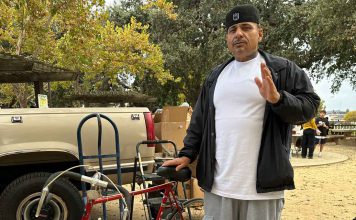Native Americans say mining operations proposed for 30 years at the sprawling Sargent Ranch in Gilroy will hurt the environment and land sacred to their tribe, but the developer says he will do all he can to protect Indian resources.
The Native Americans are fighting the plan and want “government-to-government” talks with Santa Clara County.
“Mining will totally destroy the cultural and spiritual aspects of that land, so we are going to put up major opposition,” said Valentin Lopez on Monday.
Lopez is the chairman of the Amah Mutsun Tribal Band of the Costanoan/Ohlone Indians, a people who inhabited the area for thousands of years before Europeans arrived.
“We hope the city and folks there will support our tribe and recognize the humanity and spirituality of our people,” Lopez said.
The project applicant is Verne Freeman. His firm, Freeman Associates LLC of Palo Alto, represents the landowner, the Sargent Ranch Management Company.
Freeman said Tuesday that he hosted a tour of the site last summer for some Gilroy people and will do the same for Lopez.
Opposition will not deter his firm from moving forward with the application, which was submitted last year on behalf of the more than 100 owners of the 6,400-acre ranch.
The majority owner is Debt Acquisition Company of America, according to Freeman.
It’s not uncommon in the mining industry for companies to work with Native Americans to ensure land and artifacts are safeguarded, but an initial study of the proposed mining sites found nothing, said Freeman, whose office is in Palo Alto.
He said he will meet with tribal representatives to “try to understand what their opposition is based on and what if anything we can do to work out any concerns they may have.
“We understand the tribe has history [on the land]. Certainly if anything was found we would consult with them and figure out what to do and even stop work if appropriate. We’ve done it in other projects in the state and we would be open to that kind of arrangement going forward.”
Freeman’s firm specializes in helping mining company with such projects, taking care of everything from designing the mining operation to securing government permits and approvals.
The sand mining envisioned in the Sargent Quarry project would take place at three sites with trucks using Highway 101.
Plans call for the project to occupy just over 300 acres, of which 220 would be to mine 38 million cubic yards, or 41 million tons, of sand for use in the construction industry.
The operation would create 15 to 20 “good paying” jobs, according to the project description.
Each phase of work would be followed by land reclamation and revegetation. Mitigation measures are proposed for plant and animal habitats and protected and “special status” creatures, such as the Tiger Salamander, the burrowing owl and the American badger.
An adjoining property visible from Highway 101 has been the site of aggregate, or road gravel, mining in recent years and is now in the reclamation phase, according to Minira Sandhir, principal planner with the Santa Clara County Planning Department.
Freeman’s father’s company started that operation, which is unrelated to the current proposal and was sold to Granite Construction, Freeman said.
Sandhir said the county received a letter from an attorney for the Amah Mutsun tribe and will meet with Lopez, “so that we can get them involved in the project as early as possible.”
In a letter to the county dated Oct. 13, attorney Rovianne A. Leigh, asked for “formal government-to-government” talks on the proposal and the right to monitor operations if the county approves the project.
In addition to talks with Lopez, Freeman’s proposal is undergoing an initial environmental review, to be followed by a full environmental impact report that could take up to a year, Sandhir said.
Using the Amah Mutsun word for the ranch lands, the Leigh letter states, “The goal of the consultation would be to find mutually acceptable ways to protect and preserve the unique lands and resources within the Juristac for generations to come.”
In an Oct. 31 press release, Lopez said, “To the Amah Mutsun, Juristac is as holy as Jerusalem, the middle east town that is held sacred by the Jews, Christians and Muslims.
“There can be no doubt that the proposed mining project would be the equivalent to tearing down Jerusalem to make way for a sand and gravel mining pit,” he said.
In addition to villages and hundreds of burial sites, the land was the site of the most sacred of tribal dances and is the “home of our spiritual leader,” Lopez said Monday.
Sargent Ranch runs along the western side of Highway 101 just south of Gilroy’s city limits and reaches up an over the ridge line into Santa Cruz County.
Historically, Amah Mutsun land encompassed today’s San Benito, Santa Clara, Santa Cruz, Monterey and San Mateo counties.
On Oct. 1, the 10-member tribal council unanimously passed a resolution opposing the project, writing it will “irreparably harm” tribal lands and water resources.
Another part of the resolution invokes past injustices suffered by the tribe.
“The Amah Mutsun have survived slavery, disease and other genocidal practices of European governments that invaded their lands, as expressed in Catholic mission teachings, judicial decisions and official government practices.”
Lopez continued in the press release, “We call on the Board of Supervisors to acknowledge the difficult truth regarding the history of California Indians, including how our lands were stolen from us and our traditional ways of life were destroyed.”














